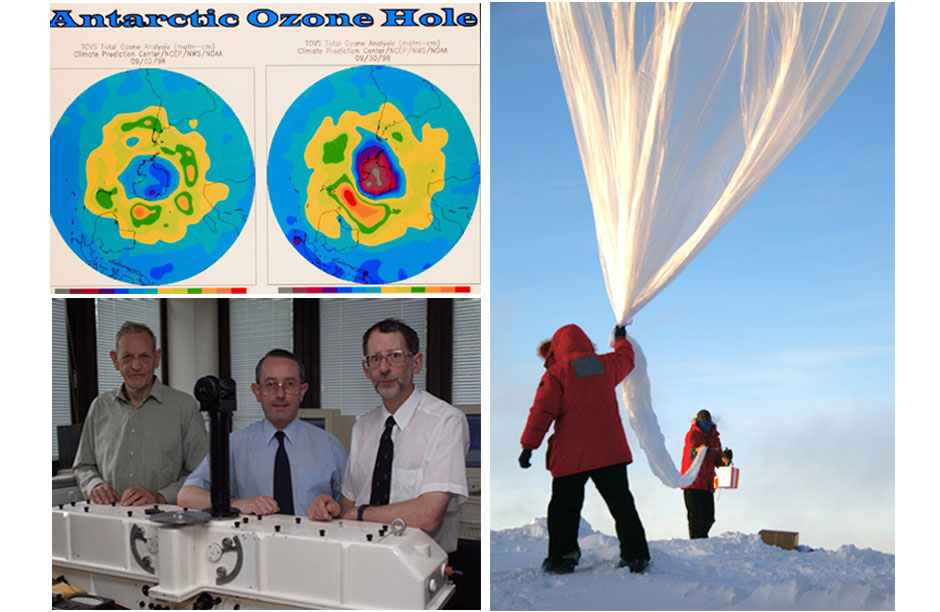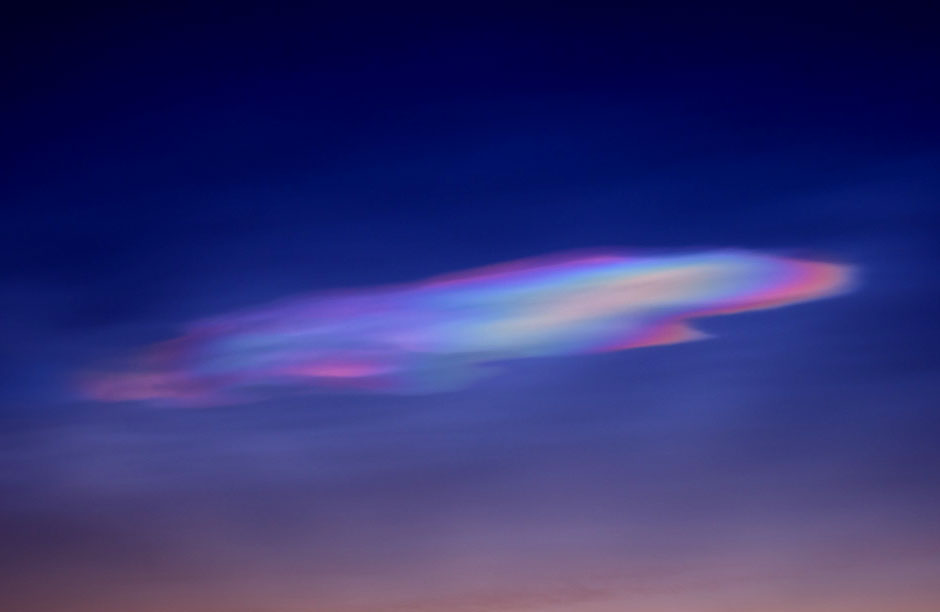PAST ISSUES
 Image Bottom Left: Joseph Farman, Brian Gardiner, Jonathan Shanklin, the three men attributed to discovering the hole in the ozone layer as part of the efforts of the British Antarctic Survey in 1985. Image Right: NOAA scientists launching a balloon to measure ozone vertically. Image Credit NOAA
Image Bottom Left: Joseph Farman, Brian Gardiner, Jonathan Shanklin, the three men attributed to discovering the hole in the ozone layer as part of the efforts of the British Antarctic Survey in 1985. Image Right: NOAA scientists launching a balloon to measure ozone vertically. Image Credit NOAA NASA’s ER-2 airplane (a converted U-2 spy plane) takes off for 65,000 ft to collect atmospheric measurements within the ozone layer. Image Courtesy of NASA
NASA’s ER-2 airplane (a converted U-2 spy plane) takes off for 65,000 ft to collect atmospheric measurements within the ozone layer. Image Courtesy of NASA “Pearl Clouds” (Nacreous clouds) form at 50,000 - 80,000 ft where they induce chemical reactions responsible for freeing active chlorine from Chlorofluorocarbon (CFC) bonds, which were engineered to be indestructible. In turn the active chlorine is responsible for the depletion of ozone protecting our atmosphere from ultraviolet rays.
“Pearl Clouds” (Nacreous clouds) form at 50,000 - 80,000 ft where they induce chemical reactions responsible for freeing active chlorine from Chlorofluorocarbon (CFC) bonds, which were engineered to be indestructible. In turn the active chlorine is responsible for the depletion of ozone protecting our atmosphere from ultraviolet rays.
Closing the Ozone Hole: How Good Science Made Good Policy
By Anna Louie SussmanIn 1985, with eleven words, eight graphs of squiggly lines and dots, four mathematical formulas and two tables of measurements, three scientists set off a wave of concern that culminated in one of the international community’s few environmental success stories: the discovery of the hole in the ozone layer, and the subsequent global effort to fight its depletion.
Instead of “Once upon a time…”, this scientific fairy tale opens with a headline: “Large losses of total ozone in Antarctica reveal seasonal ClOx/NOx interaction,” published in volume 315, May 1985, of the journal Nature. The authors of the study, J.C. Farman, B.G. Gardiner and J.D. Shanklin were researchers for the British Antarctic Survey (BAS), a Cambridge-based outfit with roots in Operation Tabarin, a World War II expedition intended to lay British claim to the Falkland Islands. By 1962, the Falkland Island Dependencies Survey had been renamed the BAS, and over a dozen research stations, some formerly military bases, were established.
Farman, Gardiner and Shanklin were based at Halley, a station located, as of 2001, at Lat. 75° 35′ S, Long. 26° 34′ W. If one was giving directions to the station, the address on the website is “Brunt Ice Shelf, Caird Coast.” Make a left at the Emperor penguin colony.
Stationed here, the three men discovered “large losses of total ozone,” as the title of their eventual article indicates, which they linked to the presence of chlorofluorocarbons (CFCs) in the atmosphere. How did this big fat hole in the ozone layer go unnoticed until 1985? According to Shanklin, writing in Nature 25 years after the discovery, “The prevailing expectation at the time was that chlorine from CFCs would affect the ozone layer by photocatalytic decomposition, and that these effects would be most marked high in the tropical stratosphere.” Instead, it appeared that the extreme cold of the Antarctic stratosphere, which can reach temperatures below -80°C, allowed for clouds to form where chlorine and bromine can destroy ozone molecules.
When the 1985 paper was released, Dr. David Fahey was getting ready to participate in a high-altitude research experiment over Australia.
“Papers like this have some induction time,” Fahey says. “The importance in the community takes some time to penetrate.” But once understood, its findings were taken to heart.
“The care with which Farman and his colleagues had made their measurements meant people couldn’t dispute it as anomalous,” he remembers. “They had been looking for a few years. This came out fully baked; it was not ‘science by press release.’”
Nine years before, F. Sherwood Rowland and Mario J. Molina, two chemists based at the University of California at Irvine, had hypothesized a link between CFCs and the destruction of ozone in the atmosphere. But as Fahey recalls, even by 1987, it was one of three competing theories still circulating as to what was causing ozone loss.
“The other two couldn’t be immediately dismissed, because we didn’t have enough information,” he remembers. “That’s when people decided to take the ER-2 and fly and see what’s actually going on down there.”
The ER-2 is a one-seat, one-pilot “Gary Powers spy plane,” according to Fahey, normally used for military reconnaissance missions thanks to its high-altitude, powered gliding capability. The National Aeronautics and Space Administration (NASA) had acquired two, one of which, beginning in August, he and his colleagues outfitted for “autonomous instrumentation,” or automatic measurement-taking. Fahey was one of about 100 scientists and support crew who worked out of a former military base in Punta Arenas, Chile, on the internationally-sponsored Airborne Antarctic Ozone Experiment.
Joining him as Mission Scientist in charge of the ER-2 flights was Adrian Tuck, now a Visiting Professor in the Physics department at Imperial College London. For him, the 1985 paper was “not a complete surprise,” since he’d been exposed to its hypotheses in an academic context. Nonetheless, its effects on his colleagues were profound.
“It had the effect of making everyone in the field drop what they were doing and focus on the ozone loss in the Antarctic vortex,” he recalls.
Down in Punta Arenas, a one-to-three-hour flight from the ozone hole, “the atmosphere was one of scientific excitement, modulated by tension and consciousness that the world’s eyes were upon us, not just those of our colleagues in the global stratospheric community,” says Tuck.
“The challenge,” Fahey says, “is to have enough dimensions to really talk about what’s going on. The idea is to measure a suite of chemicals,” to be able to really describe who’s reacting with what, way up there. A team from Harvard, led by Dr. James Anderson, had a new device, adapted from a balloon instrument, with which to measure chlorine. In total, says Tuck, “the ER-2 payload featured 12 instruments, every one of which had a significant role in the quality and impact of the final results.”
A typical day, Tuck remembers, would start at 4 a.m., when the scientists would start installing their instruments on the plane. At 6 a.m., he and a UK Meteorological Office forecaster would decide, based on wind conditions, if the pilot would be able to safely take off and land. With a green light, the plane would fly at 9 a.m., returning seven to eight hours later laden with data. Evenings were spent eating local food, drinking the excellent Chilean red wine, and poring over results.
Without the help of high-speed processors and sophisticated technology, the group did things the old-fashioned way.
“We’d print out our particular results and hang them on the wall, because that was the best way to compare,” says Fahey. “It was very heady; in a sense you could see things that no one had ever seen before.”
“In the early days, we wouldn’t find much,” remembers Fahey. “Then a month later, it was almost incontrovertible.”
In early September, as these results came in, a high-profile meeting on ozone depletion, sponsored by the United Nations Environment Programme, was taking place in Montreal, Canada. Bob Watson, the NASA Program Manager heading the mission, flew straight from Chile to Canada; one can almost imagine him storming through the doors, waving papers as the hero music plays.
“Here he was in Southern Chile, looking at raw data coming out of these measurements, and then he flew to the other end of the world,” says Fahey. It was this science – carefully measured, rigorously analyzed, and respectfully treated by the media and policymakers – that rendered naysayers mute.
“It made it possible to fend off with relative ease those who, mainly for reasons connected with the libertarian right, sought to deny the scientific truth,” adds Tuck.
The meeting concluded with the Montreal Protocol on Substances that Deplete the Ozone Layer, which laid the foundation for what is widely regarded as one of the few success stories in the history of environmentalism. To ensure universal participation, the Protocol specified mild controls on CFC emissions, and also established mechanisms to assist poorer countries in transitioning to less harmful chemicals. In subsequent meetings, the controls were tightened, and scientists predict it will ultimately recover, possibly by year 2050.
“The Protocol balanced science, economics and technology in a way that 196 nations could agree that, ‘Hey, this is something we can do,’” says Fahey. Furthermore, a scientific panel over sees its implementation, providing assessments every four years, and responding to the concerns of member states. This panel, says Fahey, “gives tremendous stability to this legal group trying to figure out what to do.”
What lessons does this victory hold for those fighting climate change?
According to Tuck, the economic, social and political factors are very different today than thirty years ago. Above all, the amount of money involved in replacing fossil fuels will prove the biggest barrier.
“It cost a few billion to deal with CFCs, it will be an unknown number of trillions to replace fossil fuels,” he says.
In the meantime, Fahey counsels patience: “Let the economic, and social and technological aspects work themselves out while the science builds up.”